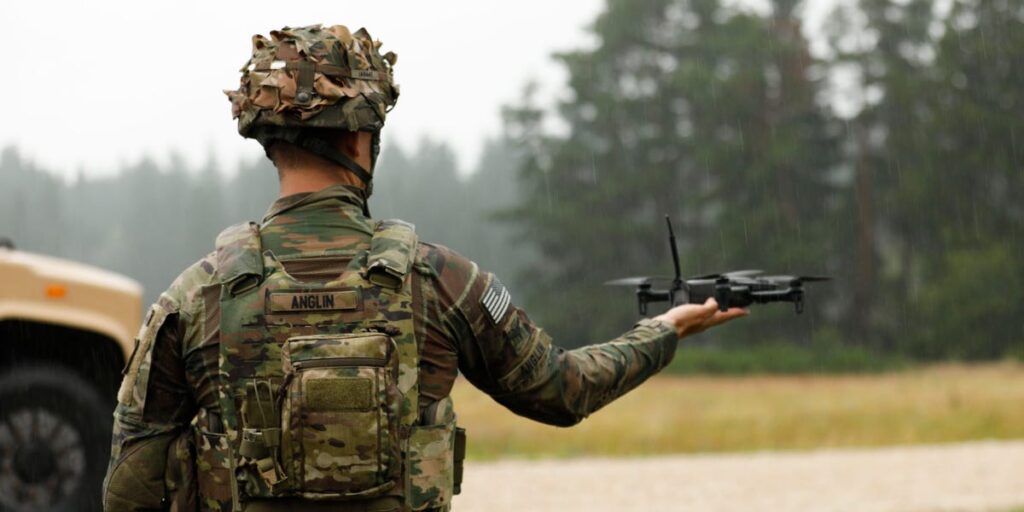The US Army has been celebrating some of its recent achievements in drone warfare, like dropping grenades from a quadcopter and scoring its first drone-on-drone kill.
These tactics, however, aren’t new. They’ve seen extensive use in Russia’s war against Ukraine. First-person-view drones dropping ordnance was commonplace years ago, and drone intercepts of other uncrewed aircraft are down to a science in Ukraine.
The Army’s recent wins highlight positive progress, but also the glaring skill gaps it needs to close to be ready to employ and respond to small, cheap combat drones. The US military is still widely working on adequately equipping troops with this capability.
Secretary of Defense Pete Hegseth wrote in a July memo that American “units are not outfitted with the lethal small drones the modern battlefield requires.”
Army drone achievements
The Army has been trailing, but recent developments suggest a game of catch-up is underway.
In July, the Army’s X account shared video in a now-deleted post that showed American soldiers dropping a live M67 grenade from a quadcopter drone during an exercise in Germany. It was the first such event in the Army for conventional forces.
The post’s caption asked the question: “Have you ever seen a drone drop a grenade?” The query drew an onslaught of online criticism, as that drone tactic has seen prominent use over the past decade, including by ISIS terrorists during the Battle of Mosul in Iraq and by both sides of Russia’s war in Ukraine.
Examples of drones dropping grenades and other explosives have been documented extensively by militaries, open-source information accounts, and war watchers. While the Army post has since been deleted, the video is still available.
The Army also recently celebrated its first drone-on-drone kill during an exercise at Fort Rucker in Alabama. This big event involved piloting a first-person view quadcopter drone armed with a Claymore mine into a fixed-wing drone. The explosive was detonated, destroying its target.
Drone-on-drone combat is a growing hallmark of the Ukraine war, with small quadcopters ramming or bombing one another in uncrewed dogfights. The tactics have evolved rapidly — yet the Army is only now testing the basics as Ukraine is putting up thousands of interceptor drones as an alternative to expensive air-defense missiles.
In other exercises, Army soldiers have found themselves out in the field with faulty video feed connections between operators and drones, missing parts, a lack of desired equipment, and unexpected damage from environmental hazards. The Ukrainians and the Russians grapple with these issues, too, but years of war have better prepared them to handle them.
Army officials acknowledge the challenges. Integrating small drone technology into the force comes with difficulties that troops are trying to overcome. Lessons learned are being documented extensively and shared across the service. It’s clear that drones are critical to modern warfare, and learning is happening, even if it is by trial and error.
That work is being done in the field, with soldiers testing how drones operate in different weather patterns in the Pacific, as well as in schoolhouses and courses. “We’re behind globally,” the head of a new crash course said recently. “This is our aggressive attempt to close the gap.”
The Army told Business Insider that progress in using small uncrewed aerial systems is ongoing beyond any single milestone or achievement, adding that “the successful fielding, integration, and operational use of sUAS are vital for maintaining a technological edge and protecting our forces.” The service also said that its work on counter-drone systems is critical.
Work in progress
Zachary Kallenborn, a drone, uncrewed capabilities, and unconventional warfare expert, told Business Insider that while there are assuredly experts and officials that are concerned about the US military’s speed in adapting to small drones, it’s also difficult to draw conclusions for overall military readiness on drone warfare, especially as other services, programs, and offices in the Pentagon are working on the technologies and capabilities as well.
For the Army, drones are a notable element of the service’s massive transformation initiative, with signs of progress already visible. Yet the work is slow, and that is not without reason.
The US hasn’t overwhelmingly needed to — or been particularly effective at — low-level experimentation with weaponry. In Ukraine, it’s strongly encouraged, Kallenborn said, “so they’ve been able to come up with all these really great things and build all these really cheap, innovative systems.”
The US also isn’t in a conflict that demands it go all-in on drone technology, purchasing millions of drones that might be obsolete by the time they’re needed. Ukraine is investing heavily in this tech because it lacks many of the capabilities available in the West. Experts have cautioned Western militaries against taking the wrong lessons from the Ukraine war and looking to drones as a replacement for conventional military strengths. Without a wartime demand, experimentation moves more slowly.
But with concerns about the possibility of a peer-level conflict, against an adversary like China, there’s a strong argument not only in favor of skilling up on offensive drone warfare, but also counter-drone capabilities. A recent report from the Center for a New American Security argued that US forces could be overwhelmed by drones in a fight with China if it isn’t adequately prepared with effective, combat-ready equipment.
Right now, the Army appears to be going through what could perhaps best be described as growing pains. As one Army drone pilot said during a recent exercise that BI attended, “We’re still so new to having drones with us.”
Read the full article here
















